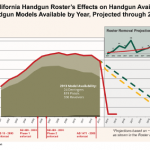Most people can delude themselves into believing they’re safe from a multitude of unfamiliar dangers. This is probably because we want to be safe from these things, but do not really know how to actually achieve that goal. Call it whistling past the graveyard, but we accept what someone else calls safety when it comes to a subject where we lack experience. Firearms safety is a case in point. Many a gun muggle will accept without question what someone with a teleprompter and a nice suit tells them.
No one, unless they’re utterly devoid of decency, wants unsafe firearms in our society. As gun owners, we drill the basic rules of gun safety into the heads of new shooters: Do not load a gun until you’re ready to use it, do not put your finger, or anything else, on the trigger until you’re about to shoot, and never, ever let the gun point at something you’re unwilling to see destroyed. We know guns and we know what they can do if mishandled. No one is more interested in gun safety than a gun owner. So when a gun owner balks at using a “safety” device, you should wonder about the device and not the gun owner.
The latest “safety” device to fail to earn the trust of gun owners is the “smart” gun. President Obama has ordered the DOD, DOJ, and Homeland Security to investigate use of these devices by government personnel. But Ars Technica founder Jon Stokes questions the efficacy of this technology. He wrote in the L.A. Times:
Gun owners are terrified of anything that might make their guns less reliable. And when they consider the frequency with which their $700 smart phone’s fingerprint scanner fails when presented with a clean, dry, perfectly-positioned thumb, they rightly conclude that putting any type of electronic lock on their Glock will likely make them less secure, not more.
Stokes also notes that “smart” guns that communicate with some sort of external device, like a big, ugly watch that only the authorized user is supposed to wear, could be detected by the same hardware credit card thieves use to sniff out RFID equipped cards. This either makes the gun owner a target for theft or it marks them as something to avoid; which then puts you, the unarmed one in the crowd, into the thief’s crosshairs.
There are other safety concerns…
- If the “smart” part of the gun fails, does it let the gun fire for anyone or no one? Either can lead to disaster if gun is in the hands of someone who can’t answer the question.
- If they’re having a really, really bad day on the job, can Officer Smith pick up Officer Jones’ “smart” gun and use it? Or does he have to get Officer Jones’ big, ugly watch first?
- Stokes notes the potential for hacking. How many police officers or soldiers would want a service weapon that the bad guys could shut off with a smartphone app?
- How many gun owners would want that same gun with its hidden remote kill switch?
- When it comes to water or gun cleaning chemicals, can the “smart” part of the gun take a joke? Most electronics don’t play well with moisture or oil.
It’s these unknowns and others that make “smart” guns so unappealing to gun owners. We realize that they make our guns less safe for us and our loved ones. This is why there’s no market for them, not some nefarious plot by the dreaded gun lobby.
So why is the President pushing the technology?
I’m going to give him the benefit of the doubt and say that, like all decent people, he wants guns to be safer. But bless his little heart, he has no idea what he’s talking about. He doesn’t understand firearms, let alone ones with untested features. He doesn’t understand how safe guns are. The number of gun related accidents has been falling in the US for decades. But rather than seek advice from the nation’s premier gun safety organization, the NRA, he sought out the opinions of other, equally ignorant, gun muggles.
And he’s going to bitterly cling to their bad advice.








Be First to Comment